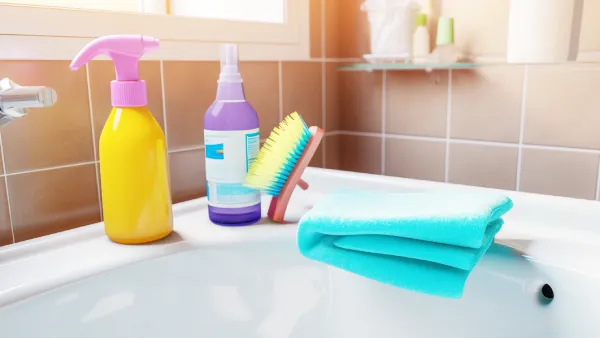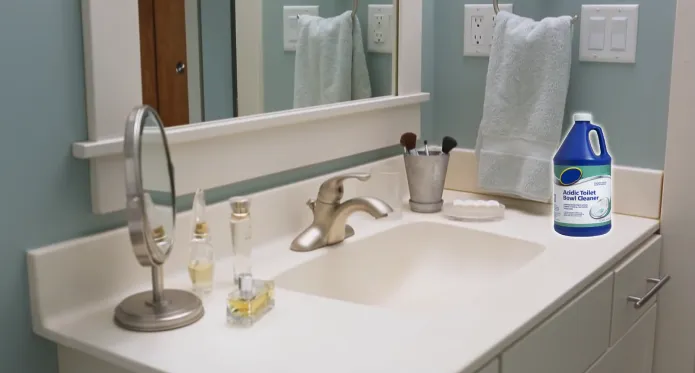Last Updated on November 12, 2023
Toilet cleaner is a powerful cleaning agent designed with one primary mission: to tackle the toughest stains and bacteria lurking in your toilet bowl. As these items are available in your home, you may wonder whether you can use toilet cleaner to clean your bathroom sink.
You can use toilet bowl cleaner in your bathroom sink in some cases, as some sink and toilet cleaners contain similar active ingredients. However, using toilet cleaner in the bathroom sink is generally not recommended.
Toilet bowl cleaners are formulated with harsh chemicals, such as hydrochloric acid and bleach, designed specifically for cleaning and disinfecting toilet bowls.
So, using toilet bowl cleaner in the sink can potentially damage sink surfaces, particularly porcelain, stainless steel, or plastic sinks.
We will examine what to consider before using toilet cleaner in the bathroom sink, as well as how to clean a bathroom sink safely without using toilet cleaner.
What to Consider When Using Toilet Cleaner in the Bathroom Sink?

When considering using toilet cleaner in the bathroom sink, there are 3 important points to remember.
- Toilet bowl cleaner ingredients
- Sink material
- Testing
1. Toilet Bowl Cleaner Ingredients
Using toilet cleaner in the bathroom sink can potentially damage the sink due to its harsh chemicals.
Toilet bowl cleaners often contain ingredients like hydrochloric acid and bleach, specifically formulated to tackle tough stains and bacteria in toilet bowls. These chemicals can be too abrasive for certain sink materials, such as porcelain or delicate surfaces.
Hydrochloric acid, for example, can corrode and etch these materials, leading to permanent damage and discoloration. Bleach, on the other hand, can cause fading or discoloration on certain sink finishes.
You need to consider the composition of the cleaner to determine whether it will be suitable for your bathroom sink. If in doubt, it’s best to use cleaning products specifically designed for sinks to avoid any potential damage.
2. Sink Material
Before using the toilet cleaner in your bathroom sink, consider the sink’s material. The material of your sink can determine whether it’s okay to use toilet cleaner without causing damage.
Different sink materials have varying levels of resistance to harsh chemicals. Porcelain and ceramic sinks are generally more resistant and can withstand the use of toilet cleaner.
Stainless steel sinks are also resistant to most toilet cleaners but may be susceptible to some abrasive cleaners.
On the other hand, natural stone sinks, such as marble or granite, are more delicate and can be easily damaged by strong chemicals.
3. Testing
To ensure the safety and effectiveness of using toilet cleaner in the bathroom sink, make sure to perform a small test in an inconspicuous area. This is because different sink materials may react differently to the chemicals in toilet cleaners.
Start by applying a small amount of the cleaner to a hidden spot, such as the underside of the sink or the back of the faucet.
Allow it to sit for a few minutes, then rinse it thoroughly with water. Observe the area for any signs of damage or discoloration.
If there are no adverse effects, you can proceed with using the toilet cleaner on the rest of the sink. Remember to always follow the instructions on the cleaner’s label and exercise caution when using any cleaning products.
How to Safely Clean a Bathroom Sink Instead of Using a Toilet Cleaner?
To safely clean a bathroom sink without using toilet cleaner, you will need mild dish soap, baking soda, white vinegar, and all-purpose bathroom cleaner.
Additionally, you will need cleaning cloths, microfiber towels, and warm water to assist in cleaning. The following steps will guide you through the process of cleaning your bathroom sink:
Step 1: Prepare the Bathroom Sink
To start cleaning your bathroom sink, clear the sink of any items such as toothbrushes, soap dishes, or debris.
Additionally, plug the sink drain if necessary to avoid any water from running down the drain during the cleaning process.
Step 2: Rinse the Sink
Before beginning to clean the sink, it is essential to rinse it thoroughly. By rinsing the sink thoroughly with warm water, you’ll help remove any loose debris and prepare the surface for cleaning.
Step 3: Apply the Cleaner
When choosing a cleaning agent, you have several options. You can use mild dish soap, all-purpose bathroom cleaner, or baking soda mixed with water. For mild stains, dish soap works wonders.
Place a small quantity of dish soap onto a damp cloth or directly onto the sink’s surface, and work the soap into a lather.
For tougher stains, you can use all-purpose bathroom cleaners. Spray the cleaner evenly over the sink surface and let it sit for a few minutes before scrubbing.
As for baking soda, you can use it to make a paste that you can apply to stained or dirty areas. You can optionally apply white vinegar to remove limescale.
Step 4: Scrub Your Bathroom Sink
Once you’ve applied your chosen cleaner, it’s time to scrub the surface using a cloth or a soft sponge. Pay special attention to corners, faucets, and areas with scum or stains.
Be gentle while scrubbing to minimize scuffing or damaging the sink surface. Use a soft toothbrush and a paste made from baking soda and water for harder-to-reach areas or stubborn stains.
Step 5: Rinse
Use lukewarm water to clean the sink thoroughly, making sure there are no residues left behind. If you use baking soda and vinegar, the fizzing action will help lift dirt and stains. Removing all traces of soap or cleaner leaves your bathroom sink sparkly clean and free of bacteria and germs.
Can you mix toilet cleaner with another cleaner to clean your bathroom sink?

You should never combine a toilet cleaner with another cleaner when cleaning your bathroom sink. Mixing different cleaners can result in chemical reactions that can be dangerous to your health and the condition of your sink.
Combining these cleaners can produce harmful fumes or substances that can irritate your respiratory system or skin. The chemical reactions may cause damage to your sink’s surfaces or even your plumbing.
It’s always best to use a cleaner specifically designed for bathroom sinks, as these products are formulated to effectively remove dirt and grime without causing any harm. Always follow the manufacturer’s instructions for proper usage to ensure a thorough and safe cleaning process.
Clean Your Bathroom Sink with the Right Products and Protect its Longevity
We now understand that using toilet cleaner in the sink isn’t recommended as it may contain harsh chemicals that can damage the sink’s surface or fixtures.
You have to consider the material of your sink, the cleaner’s composition and perform a test in an inconspicuous area before attempting to use it on the entire sink.
Opting for cleaning products specifically designed for sinks is the safest and most effective approach.
With safe sink cleaning steps and avoiding mixing different cleaners, your bathroom sink will stay clean and damage-free.
Prioritizing safety and the longevity of your sink is key to maintaining a pristine and functional bathroom.

